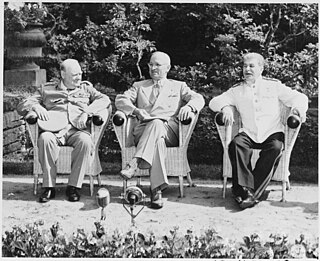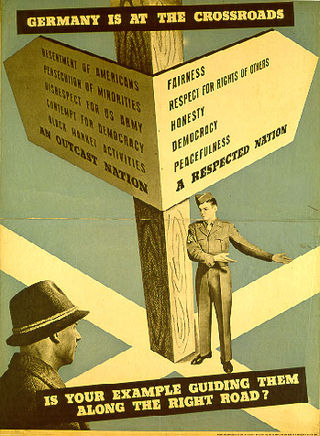Related Research Articles

The Potsdam Conference was held at Potsdam in the Soviet occupation zone from July 17 to August 2, 1945, to allow the three leading Allies to plan the postwar peace, while avoiding the mistakes of the Paris Peace Conference of 1919. The participants were the Soviet Union, the United Kingdom, and the United States. They were represented respectively by General Secretary Joseph Stalin, Prime Ministers Winston Churchill and Clement Attlee, and President Harry S. Truman. They gathered to decide how to administer Germany, which had agreed to an unconditional surrender nine weeks earlier. The goals of the conference also included establishing the postwar order, solving issues on the peace treaty, and countering the effects of the war.

The Potsdam Agreement was the agreement among three of the Allies of World War II: the United Kingdom, the United States, and the Soviet Union after the war ended in Europe on 1 August 1945 and it was published the next day. A product of the Potsdam Conference, it concerned the military occupation and reconstruction of Germany, its border, and the entire European Theatre of War territory. It also addressed Germany's demilitarisation, reparations, the prosecution of war criminals and the mass expulsion of ethnic Germans from various parts of Europe. France was not invited to the conference but formally remained one of the powers occupying Germany.

The Potsdam Declaration, or the Proclamation Defining Terms for Japanese Surrender, was a statement that called for the surrender of all Japanese armed forces during World War II. On July 26, 1945, United States President Harry S. Truman, United Kingdom Prime Minister Winston Churchill, and Chairman of China Chiang Kai-shek issued the document, which outlined the terms of surrender for the Empire of Japan, as agreed upon at the Potsdam Conference. The ultimatum stated that, if Japan did not surrender, it would face "prompt and utter destruction."

The Constitution of Japan is the constitution of Japan and the supreme law in the state. It was written primarily by American civilian officials working under the Allied occupation of Japan after World War II. The current Japanese constitution was promulgated as an amendment of the Meiji Constitution of 1890 on 3 November 1946 when it came into effect on 3 May 1947.

Japan was occupied and administered by the Allies of World War II from the surrender of the Empire of Japan on September 2, 1945, at the war's end until the Treaty of San Francisco took effect on April 28, 1952. The occupation, led by the American military with support from the British Commonwealth and under the supervision of the Far Eastern Commission, involved a total of nearly one million Allied soldiers. The occupation was overseen by the US General Douglas MacArthur, who was appointed Supreme Commander for the Allied Powers by the US President Harry S. Truman; MacArthur was succeeded as supreme commander by General Matthew Ridgway in 1951. Unlike in the occupations of Germany and Austria, the Soviet Union had little to no influence in Japan, declining to participate because it did not want to place Soviet troops under MacArthur's direct command.

The Treaty of San Francisco, also called the Treaty of Peace with Japan, re-established peaceful relations between Japan and the Allied Powers on behalf of the United Nations by ending the legal state of war, military occupation and providing for redress for hostile actions up to and including World War II. It was signed by 49 nations on 8 September 1951, in San Francisco, California, at the War Memorial Opera House. Italy and China were not invited, the latter due to disagreements on whether the Republic of China or the People's Republic of China represented the Chinese people. Korea was also not invited due to a similar disagreement on whether South Korea or North Korea represented the Korean people.

The Supreme Commander for the Allied Powers was the title held by General Douglas MacArthur during the United States-led Allied occupation of Japan following World War II. It issued SCAP Directives to the Japanese government, aiming to suppress its "militaristic nationalism". The position was created at the start of the occupation of Japan on August 14, 1945. It was originally styled the Supreme Commander of the Allied Powers.
Following the termination of hostilities in World War II, the Allies were in control of the defeated Axis countries. Anticipating the defeat of Germany and Japan, they had already set up the European Advisory Commission and a proposed Far Eastern Advisory Commission to make recommendations for the post-war period. Accordingly, they managed their control of the defeated countries through Allied Commissions, often referred to as Allied Control Commissions (ACC), consisting of representatives of the major Allies.
The Reverse Course is the name commonly given to a shift in the policies of the U.S. government and the U.S.-led Allied occupation of Japan as they sought to reform and rebuild Japan after World War II. The Reverse Course began in 1947, at a time of rising Cold War tensions. As a result of the Reverse Course, the emphasis of Occupation policy shifted from the demilitarization and democratization of Japan to economic reconstruction and remilitarization of Japan in support of U.S. Cold War objectives in Asia. This involved relaxing and in some cases even partially undoing earlier reforms the Occupation had enacted in 1945 and 1946. As a U.S. Department of State official history puts it, "this 'Reverse Course'… focused on strengthening, not punishing, what would become a key Cold War ally."

The Declaration by United Nations was the main treaty that formalized the Allies of World War II and was signed by 47 national governments between 1942 and 1945. On 1 January 1942, during the Arcadia Conference, the Allied "Big Four"—the United States, the United Kingdom, the Soviet Union, and China—signed a short document which later came to be known as the United Nations Declaration, and the next day the representatives of 22 other nations added their signatures.

General Order No. 1 for the surrender of Japan was prepared by the United States Joint Chiefs of Staff and approved by President Harry Truman on August 17, 1945.
World War II officially ended in Asia on September 2, 1945, with the surrender of Japan on the USS Missouri. Before that, the United States dropped two atomic bombs on Japan, and the Soviet Union declared war on Japan, causing Emperor Hirohito to announce the acceptance of the Potsdam Declaration on August 15, 1945, which would eventually lead to the surrender ceremony on September 2.

The United States Army Military Government in Korea (USAMGIK) was the official ruling body of the southern half of the Korean Peninsula from 8 September 1945 to 15 August 1948.

The entirety of Germany was occupied and administered by the Allies of World War II from the Berlin Declaration on 5 June 1945 to the establishment of West Germany on 23 May 1949. Unlike occupied Japan, Germany was stripped of its sovereignty and former state: after Nazi Germany surrendered on 8 May 1945, four countries representing the Allies asserted joint authority and sovereignty through the Allied Control Council (ACC). At first, Allied-occupied Germany was defined as all territories of Germany before the 1938 Nazi annexation of Austria; the Potsdam Agreement on 2 August 1945 defined the new eastern German border by giving Poland and the Soviet Union all regions of Germany east of the Oder–Neisse line and divided the remaining "Germany as a whole" into four occupation zones, each administered by one of the Allies.

The Office of Military Government, United States was the United States military-established government created shortly after the end of hostilities in occupied Germany in World War II. Under General Lucius D. Clay, it administered the area of Germany and sector of Berlin controlled by the United States Army. The Allied Control Council comprised military authorities from the United States, the United Kingdom, the Soviet Union and France. Though created on January 1, 1946, OMGUS previously reported to the U.S. Group Control Council, Germany (USGCC), which existed from May 8, 1945, until October 1, 1945. OMGUS was eliminated on December 5, 1949, and the U.S. High Commissioner for Germany assumed control of its functions.

The British Military Administration (BMA) was the interim administrator of British Malaya from August 1945, the end of World War II, to the establishment of the Malayan Union in April 1946. The BMA was under the direct command of the Supreme Allied Commander South East Asia, Lord Louis Mountbatten. The administration had the dual function of maintaining basic subsistence during the period of reoccupation, and also of imposing the state structure upon which post-war imperial power would rest.
The Far Eastern Commission (FEC) was an Allied commission which succeeded the Far Eastern Advisory Commission (FEAC), and oversaw the Allied Council for Japan following the end of World War II. Based in Washington, D.C., it was first agreed on at the Moscow Conference of Foreign Ministers, and made public in communique issued at the end of the conference on December 27, 1945. The 9 members that comprised the commission were the United States, United Kingdom, Republic of China, France, the Netherlands, Australia, New Zealand, India and the Philippines. As agreed in the communique, the FEC and the Council were dismantled following the Japanese Peace Treaty of September 8, 1951.

The Allied Control Council (ACC) or Allied Control Authority, and also referred to as the Four Powers, was the governing body of the Allied occupation zones in Germany (1945–1949/1991) and Austria (1945–1955) after the end of World War II in Europe. After the defeat of the Nazis, Germany and Austria were occupied as two different areas, both by the same four Allies. Both were later divided into four zones by the 1 August 1945 Potsdam Agreement. Its members were the Soviet Union, the United Kingdom, the United States, and France. The organisation was based in Schöneberg, Berlin.

Eleanor Martha Hadley was an American economist and policymaker. Because of her relatively rare research specialization in Japanese economics, during World War II Hadley was recruited first into OSS and then the State Department to support the United States' war effort while she was a doctoral candidate in economics at Radcliffe College. Hadley helped draft the United States' plans for dissolving zaibatsu business conglomerates as part of a planned effort to democratize Japan after the war, and she participated in implementing this economic deconcentration program when the postwar occupation brought her to Japan to work for SCAP as an economist.
The Red Purge was an anticommunist movement in occupied Japan from the late 1940s to the early 1950s. Carried out by the Japanese government and private corporations with the aid and encouragement of the Supreme Commander for the Allied Powers (SCAP), the Red Purge saw tens of thousands of alleged members, supporters, or sympathizers of left-wing groups, especially those said to be affiliated with the Japanese Communist Party, removed from their jobs in government, the private sector, universities, and schools. The Red Purge emerged from rising Cold War tensions and the Red Scare after World War II, and was a significant element within a broader "Reverse Course" in Occupation policies. The Red Purge reached a peak following the outbreak of the Korean War in 1950, began to ease after General Douglas MacArthur was replaced as commander of the Occupation by General Matthew Ridgway in 1951, and came to a final conclusion with the end of the Occupation in 1952.